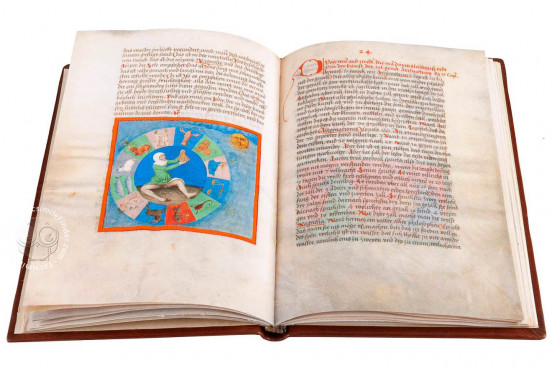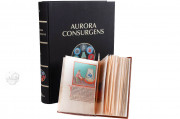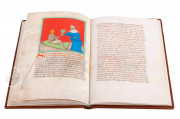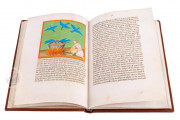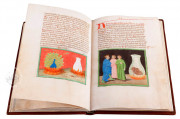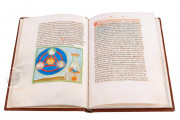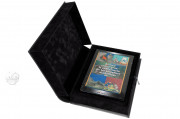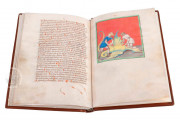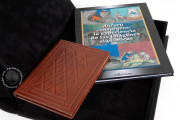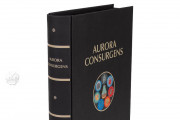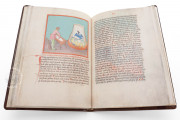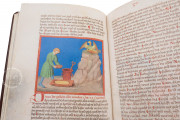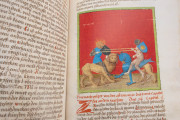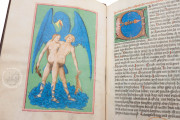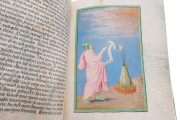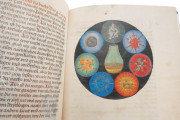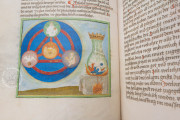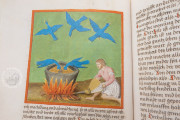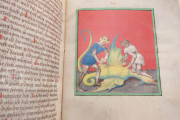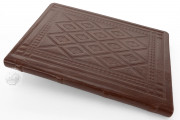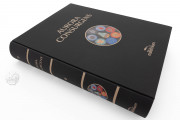The Berlin Aurora consurgens (Staatsbibliothek zu Berlin, MS germ. qu. 848) is a German alchemical manuscript produced in the early sixteenth century. It transmits a vernacular version of the Aurora consurgens — a treatise long attributed, though dubiously, to Thomas Aquinas. Written on parchment and illuminated with a remarkable series of alchemical miniatures, the manuscript bridges scholastic theology, Arabic–Latin alchemy, and Renaissance visual culture. Today it offers one of the most visually elaborate witnesses to mystical alchemy in early modern Germany.
Alchemy and Vernacular Knowledge
Around 1500, German-speaking regions became fertile ground for vernacular scientific writing. The Aurora consurgens exemplifies this shift: originally a Latin commentary on Ibn Umayl’s tenth-century Arabic Kitāb al-Māʾ al-Waraqī (“Book of the Silvery Water”), the work was translated into German for readers beyond monastic or university circles. The Berlin manuscript shows how alchemy evolved from a guarded art into a moral and cosmological discourse accessible to lay readers.
Mystical Alchemy and Pseudo-Aquinas
The title “Rising Dawn” signals illumination through the coniunctio oppositorum — the mystical union of opposites. Though often linked to Thomas Aquinas, stylistic and theological evidence points to a later Dominican author known as Pseudo-Aquinas. This writer reimagined chemical transformation as divine ascent, turning fusion, dissolution, and purification into allegories of spiritual perfection.
Alchemy in Image and Symbol
The Berlin codex includes about thirty-one miniatures forming a coherent visual sequence. Each scene illustrates an alchemical operation: the marriage of Sun and Moon, purification by fire, and the resurrection of matter. The Berlin cycle of illustrations retains narrative integrity, guiding readers from prima materia to transmutation. The visual program blends Gothic figuration with early-Renaissance spatial depth, rare in alchemical manuscripts.
Intellectual Afterlife
The Berlin Aurora consurgens charts a distinct intellectual journey. Emerging from a devotional context, it marks the migration of alchemical ideas from Latin scholasticism to vernacular courts and workshops. By the nineteenth century, it entered the Staatsbibliothek zu Berlin, part of a broader movement to preserve esoteric texts as cultural heritage. Its study helped redefine alchemy as intellectual history.
From Alchemy to Art History
The Berlin Aurora consurgens remains key to alchemical iconography. Its miniatures bridge manuscript illumination and printed emblems of early modern alchemy. Art historians see in it a precursor to Michael Maier’s Atalanta Fugiens; historians of science trace its synthesis of Arabic chemistry and Christian mysticism. It captures an age when art, theology, and natural philosophy shared the same pursuit — the transformation of matter and spirit.
Insights from the Commentary
1. The Vernacular Turn and Its Audience
The Berlin Aurora consurgens exemplifies a decisive shift from Latin scholasticism to a more personal, vernacular form of spiritual alchemy. The commentary highlights how the translator/compilator adapted dense Latin into rhythmical, moral German prose that appealed to readers beyond the cloister — educated artisans, court scholars, and pious collectors. In this manuscript, alchemy becomes a mode of meditation rather than experiment. German’s concreteness lets metaphors of melting, fusion, and rebirth gain new moral resonance, aligning the manuscript with devotional currents such as the Devotio Moderna.
2. Theological Dimensions of Alchemy
The manuscript frames alchemy as contemplative science grounded in divine order. The anonymous author, Pseudo-Aquinas, merges scholastic terminology with the mystical lexicon of the Song of Songs. Feminine mercury and masculine sulfur signify more than substances: they figure the soul and intellect striving for unity in God. Here the philosopher’s stone is not a material goal but the soul’s perfected state — a bridge between monastic theology and Renaissance humanism that turns the vessel into a symbol of the heart purified by divine fire.
3. Historical Significance
The commentary situates MS germ. qu. 848 in early sixteenth-century southern Germany, plausibly linked to workshops (e.g., Augsburg, Nuremberg) known for scientific illustration. Its miniatures echo the visual vocabulary of early printmakers (e.g., the Master of the Playing Cards), revealing a shared grammar of transformation in art and alchemy. By the nineteenth century the manuscript had entered Berlin’s public library; scholars such as Ferdinand Höfer and Marcellin Berthelot helped reclassify alchemy as intellectual heritage — and the Aurora consurgens as evidence of Europe’s synthesis of science, faith, and image.
We have 1 facsimile edition of the manuscript "Berlin Aurora Consurgens": Aurora Consurgens facsimile edition, published by Millennium Liber, 2023
Request Info / Price

